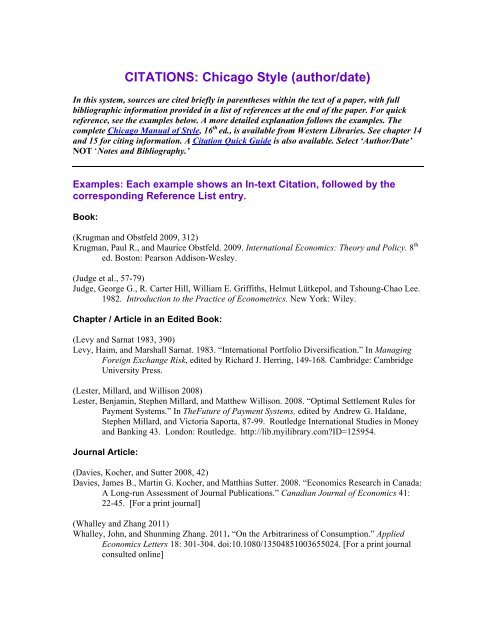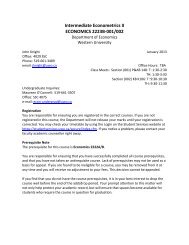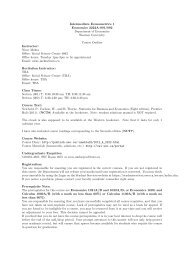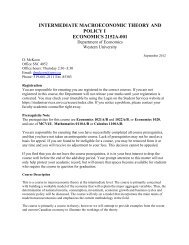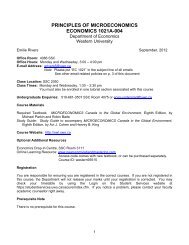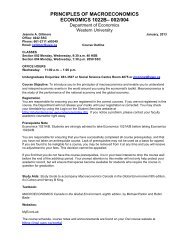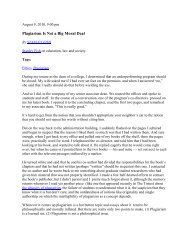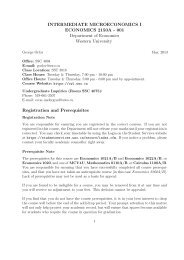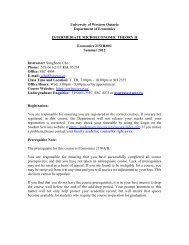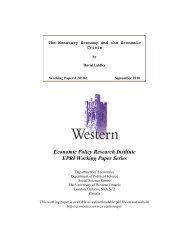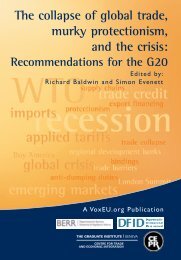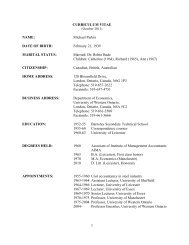CITATIONS: Chicago Style (author/date) - Economics - University of ...
CITATIONS: Chicago Style (author/date) - Economics - University of ...
CITATIONS: Chicago Style (author/date) - Economics - University of ...
You also want an ePaper? Increase the reach of your titles
YUMPU automatically turns print PDFs into web optimized ePapers that Google loves.
<strong>CITATIONS</strong>: <strong>Chicago</strong> <strong>Style</strong> (<strong>author</strong>/<strong>date</strong>)<br />
In this system, sources are cited briefly in parentheses within the text <strong>of</strong> a paper, with full<br />
bibliographic information provided in a list <strong>of</strong> references at the end <strong>of</strong> the paper. For quick<br />
reference, see the examples below. A more detailed explanation follows the examples. The<br />
complete <strong>Chicago</strong> Manual <strong>of</strong> <strong>Style</strong>, 16 th ed., is available from Western Libraries. See chapter 14<br />
and 15 for citing information. A Citation Quick Guide is also available. Select ‘Author/Date’<br />
NOT ‘Notes and Bibliography.’<br />
Examples: Each example shows an In-text Citation, followed by the<br />
corresponding Reference List entry.<br />
Book:<br />
(Krugman and Obstfeld 2009, 312)<br />
Krugman, Paul R., and Maurice Obstfeld. 2009. International <strong>Economics</strong>: Theory and Policy. 8 th<br />
ed. Boston: Pearson Addison-Wesley.<br />
(Judge et al., 57-79)<br />
Judge, George G., R. Carter Hill, William E. Griffiths, Helmut Lütkepol, and Tshoung-Chao Lee.<br />
1982. Introduction to the Practice <strong>of</strong> Econometrics. New York: Wiley.<br />
Chapter / Article in an Edited Book:<br />
(Levy and Sarnat 1983, 390)<br />
Levy, Haim, and Marshall Sarnat. 1983. “International Portfolio Diversification.” In Managing<br />
Foreign Exchange Risk, edited by Richard J. Herring, 149-168. Cambridge: Cambridge<br />
<strong>University</strong> Press.<br />
(Lester, Millard, and Willison 2008)<br />
Lester, Benjamin, Stephen Millard, and Matthew Willison. 2008. “Optimal Settlement Rules for<br />
Payment Systems.” In TheFuture <strong>of</strong> Payment Systems, edited by Andrew G. Haldane,<br />
Stephen Millard, and Victoria Saporta, 87-99. Routledge International Studies in Money<br />
and Banking 43. London: Routledge. http://lib.myilibrary.com?ID=125954.<br />
Journal Article:<br />
(Davies, Kocher, and Sutter 2008, 42)<br />
Davies, James B., Martin G. Kocher, and Matthias Sutter. 2008. “<strong>Economics</strong> Research in Canada:<br />
A Long-run Assessment <strong>of</strong> Journal Publications.” Canadian Journal <strong>of</strong> <strong>Economics</strong> 41:<br />
22-45. [For a print journal]<br />
(Whalley and Zhang 2011)<br />
Whalley, John, and Shunming Zhang. 2011. “On the Arbitrariness <strong>of</strong> Consumption.” Applied<br />
<strong>Economics</strong> Letters 18: 301-304. doi:10.1080/13504851003655024. [For a print journal<br />
consulted online]
(Caucutt and Kumar 2008, 13)<br />
Caucutt, Elizabeth M., and Krishna B. Kumar. 2008. “Africa: Is Aid an Answer?” The B.E.<br />
Journal <strong>of</strong> Macroeconomics 8 (1) (Advances), Article 32: 1-46.<br />
http://www.bepress.com/bejm/vol8/iss1/art322 [For a journal published online]<br />
Working Paper / Unpublished Work:<br />
(Fryer and Levitt 2005)<br />
Fryer, Rolland G., Jr., and Steven D. Levitt. 2005. “The Black-white Test Score Gap through the<br />
Third Grade.” NBER Working Paper 1049, National Bureau <strong>of</strong> Economic Research,<br />
Cambridge, MA.<br />
(Goltsman and Pavlov 2008, 13)<br />
Goltsman, Maria, and Gregory Pavlov. 2008. “How to Talk to Multiple Audiences.” Department<br />
<strong>of</strong> <strong>Economics</strong> Research Report 2008-1, <strong>University</strong> <strong>of</strong> Western Ontario, London, Ontario.<br />
http://economics.uwo.ca/econref/WorkingPapers/researchreports/wp2008/wp2008_1.pdf<br />
(Smith 2009)<br />
Smith, Roger. 2009. “Some Thoughts on the Harmonized Sales Tax.” Photocopy, Department <strong>of</strong><br />
<strong>Economics</strong>, York <strong>University</strong>, Toronto.<br />
Website:<br />
(Statistics Canada 2006)<br />
Statistics Canada. 2006. How to Cite Statistics Canada Products. Catalogue no. 12-591-XWE.<br />
Ottawa: Statistics Canada. Version up<strong>date</strong>d March 31.<br />
http://www.statcan.gc.ca/pub/12-591-x/12-591-x2009001-eng.htm<br />
(Berube 2009)<br />
Berube, Alan. 2009. “Recovery? Depends on Where You Look.” Up Front Blog, December 16.<br />
Washington, D.C.: Brookings Institution. Accessed April 1, 2009.<br />
http://www.brookings.edu/opinions/2009/1215_recovery_berube.aspx<br />
(OECD 2009)<br />
Organisation for Economic Co-Operation and Development (OECD)*. 2009. “Governments<br />
Agree to Step up Fight against Bribery. December 16. Accessed April 13, 2010.<br />
http://www.oecd.org/document/35/0,3343,en_2649_34487_44232739_1_1_1_1,00.html<br />
*Acronym is added if the work is cited in the text.<br />
Multiple Works by Same Author(s):<br />
(Laidler 2004a, 335)<br />
Laidler, David E. W. 1991. How shall we Govern the Governor? A Critique <strong>of</strong> the Governance <strong>of</strong><br />
the Bank <strong>of</strong> Canada. Canada Round 1. Toronto: C. D. Howe Institute.<br />
———, ed. 1997. Where we Go from Here: Inflation Targets in Canada’s Monetary Policy<br />
Regime. Policy Study 29. Toronto: C. D. Howe Institute.<br />
———. 2004a. “Monetary Policy after the Bubbles Burst: The Zero Lower Bound, the Liquidity<br />
Trap and the Credit Deadlock.” Canadian Public Policy 30: 333-340.<br />
http://www.jstor.org/stable/3552306<br />
——— . 2004b. “Monetary Policy without Money: Hamlet without the Ghost.” In<br />
Macroeconomics, Monetary Policy, and Financial Stability: A Festschrift in Honour <strong>of</strong><br />
2
Charles Freedman. Ottawa: Bank <strong>of</strong> Canada. Proceedings <strong>of</strong> a conference held by the<br />
Bank <strong>of</strong> Canada, June 2003.<br />
Citations & Reference List: Brief Description<br />
In-text (parenthetical) Citations:<br />
Last name Year, Page numbers (if relevant)<br />
Omit ‘ed.’, ‘trans.’ etc.; don’t use pp. or p.<br />
Use ‘n. d.’ if work is not <strong>date</strong>d<br />
For 4 or more <strong>author</strong>s, use first <strong>author</strong>’s last name with ‘et al.’<br />
If the Author is referred to in the text, only the year and pages appear in parenthesis; the<br />
name is not repeated<br />
The parenthetical reference goes before a punctuation mark, if practical, or in the most<br />
logical place<br />
If the <strong>author</strong> has more than one work in the same year, add lower case letters to the <strong>date</strong>s<br />
in the in-text citation and the reference list. e.g. 2007a and 2007b<br />
Examples: (Wonnacott and Wonnacott 1998, 53); / (Bank <strong>of</strong> Canada n.d., 4-8) / (Davies, Zhang,<br />
and Zeng 2005) / (Smith et al. 2002, 112-119) / (King 1996, fig. 7) / Krugman (2009) argues<br />
that… / King and Radford (2009, 56) demonstrate… / In a study by Wegman et al. (1997), …<br />
Reference List (titled ‘References’ or ‘Works Cited’):<br />
<br />
<br />
<br />
<br />
<br />
<br />
<br />
<br />
<br />
<br />
Arrange items alphabetically by <strong>author</strong>, and chronologically within a group <strong>of</strong> works by<br />
the same <strong>author</strong>(s). Interfile books, articles, etc. If no <strong>author</strong> is given, start with the title,<br />
then the <strong>date</strong><br />
Indent the second and following lines for each entry (“hanging indent” format)<br />
Separate main elements within each entry with a period [Author. Year. Title.<br />
Publication information.]<br />
List all Authors, using full names as given. Only the name <strong>of</strong> the first <strong>author</strong> is inverted<br />
(last name, first name). Use commas between names where there is more than one <strong>author</strong>.<br />
‘Author’ can refer to editors, compilers or organizations. For corporate <strong>author</strong>s, write the<br />
organization’s name in full [e.g. International Monetary Fund]<br />
For multiple entries by the same <strong>author</strong>(s), a 3-em dash* replaces the name(s) after the<br />
first entry. * ——— = ctl alt NumPadMinus x 3<br />
Year <strong>of</strong> publication follows the <strong>author</strong>(s) for all entries. If no <strong>date</strong> is given, use ‘n. d.’<br />
All Titles are capitalized headline style, i.e. first letter <strong>of</strong> all major words are in upper<br />
case<br />
Italicize the titles <strong>of</strong> books and the names <strong>of</strong> journals, magazines, newspapers, etc.; use<br />
a colon between a title and a subtitle. Article titles are put in quotation marks.<br />
Publication information for books: City: Publisher. Use first city listed; add province,<br />
state or country only if city name is unfamiliar or ambiguous. Page numbers are not used<br />
for books. See examples for edition, volume, series.<br />
Publication information for journal articles: Author(s). Year <strong>of</strong> publication. “Title <strong>of</strong><br />
Article.” Title <strong>of</strong> Journal volume: page numbers (for entire article). doi (if available) for<br />
journals consulted online. Use the url for online journal articles if no DOI is provided.<br />
3
Electronic Resources:<br />
<br />
<br />
<br />
<br />
<br />
<br />
<br />
Requirements and principles are the same as for print material. Add URL for online<br />
material, and medium consulted for CD-ROMs, DVDs, etc.<br />
Add a DOI for online journal articles, if one is provided, instead <strong>of</strong> an URL.<br />
Access <strong>date</strong> is not necessary for stable sources; use <strong>date</strong> retrieved for time-sensitive data<br />
or where information is likely to be up<strong>date</strong>d<br />
Where a website doesn’t provide the standard elements required for a proper citation, add<br />
a statement describing the source, along with the URL<br />
More informal web content (blogs, commentary, etc.) is treated like an unpublished<br />
document. If possible, cite in the running text and omit from the Reference list.<br />
When a website requires that you be inventive when creating a citation, make it logical<br />
and as consistent as possible with the standard conventions<br />
If a website has disappeared since you consulted it, add a note to that effect (accessed<br />
September 24, 2009; site now discontinued)<br />
Footnotes / Appendices<br />
Using superscript, number notes consecutively throughout paper.<br />
Numbers follow punctuation (like this. 2 )<br />
Put footnotes at the bottom <strong>of</strong> the page rather than at the end <strong>of</strong> the paper.<br />
Tables have their own notation (usually letters) specific to the table. Notes go<br />
immediately below the table body<br />
Avoid long, digressive notes. Simplify them or integrate them into the text<br />
Complicated tabular material, lists or other items not an essential part <strong>of</strong> the text but<br />
helpful to the reader should be put in an Appendix<br />
REFERENCES<br />
The <strong>Chicago</strong> Manual <strong>of</strong> <strong>Style</strong> Online. 2010. 16th ed. <strong>Chicago</strong>: <strong>University</strong> <strong>of</strong> <strong>Chicago</strong> Press.<br />
http://www.chicagomanual<strong>of</strong>style.org/home.html<br />
Turabian, Kate L. 1996. A Manual for Writers <strong>of</strong> Term Papers, Theses, and Dissertations. 6th ed.<br />
Rev. John Grossman and Alice Bennett. <strong>Chicago</strong>: <strong>University</strong> <strong>of</strong> <strong>Chicago</strong> Press.<br />
4


